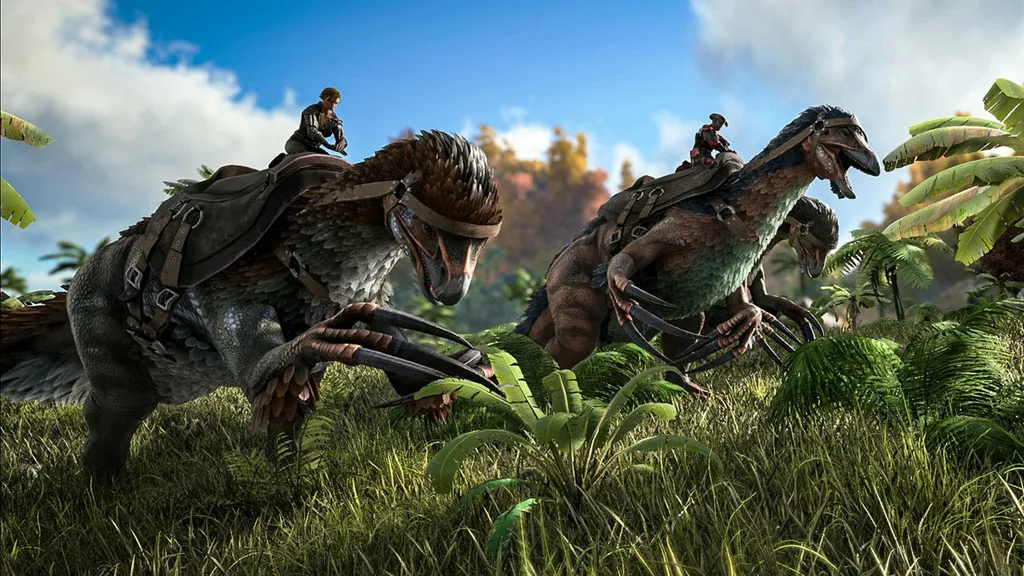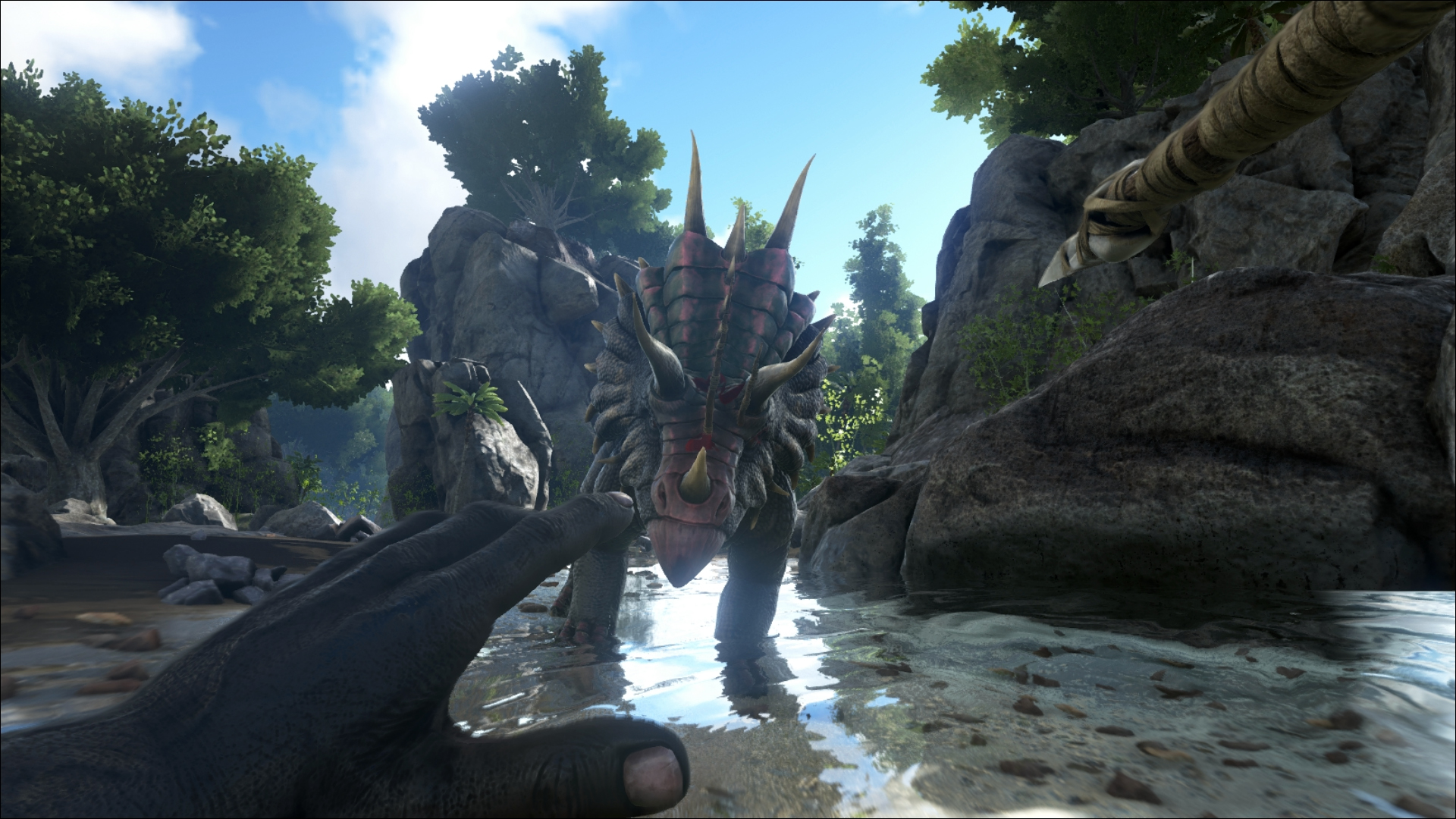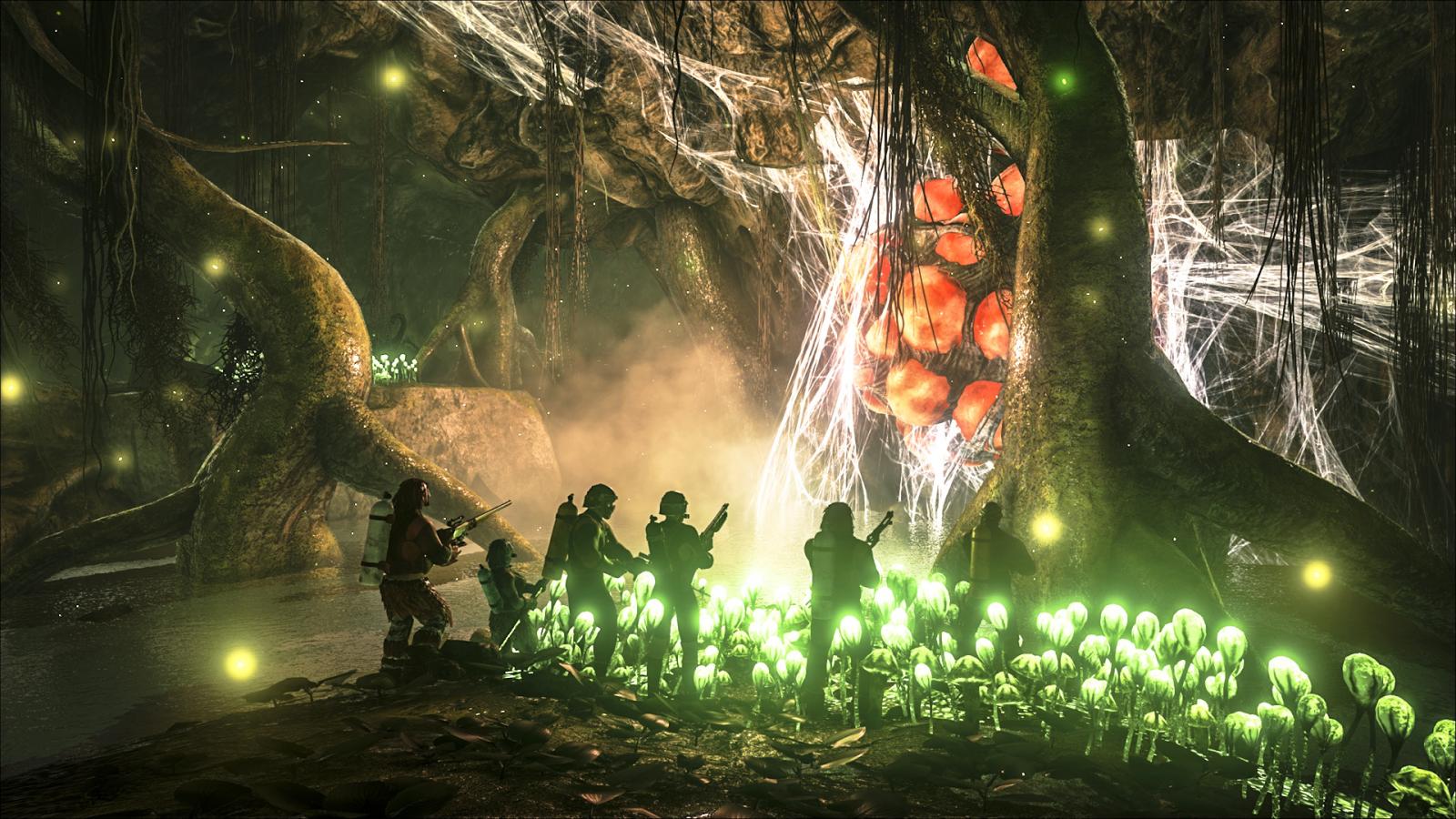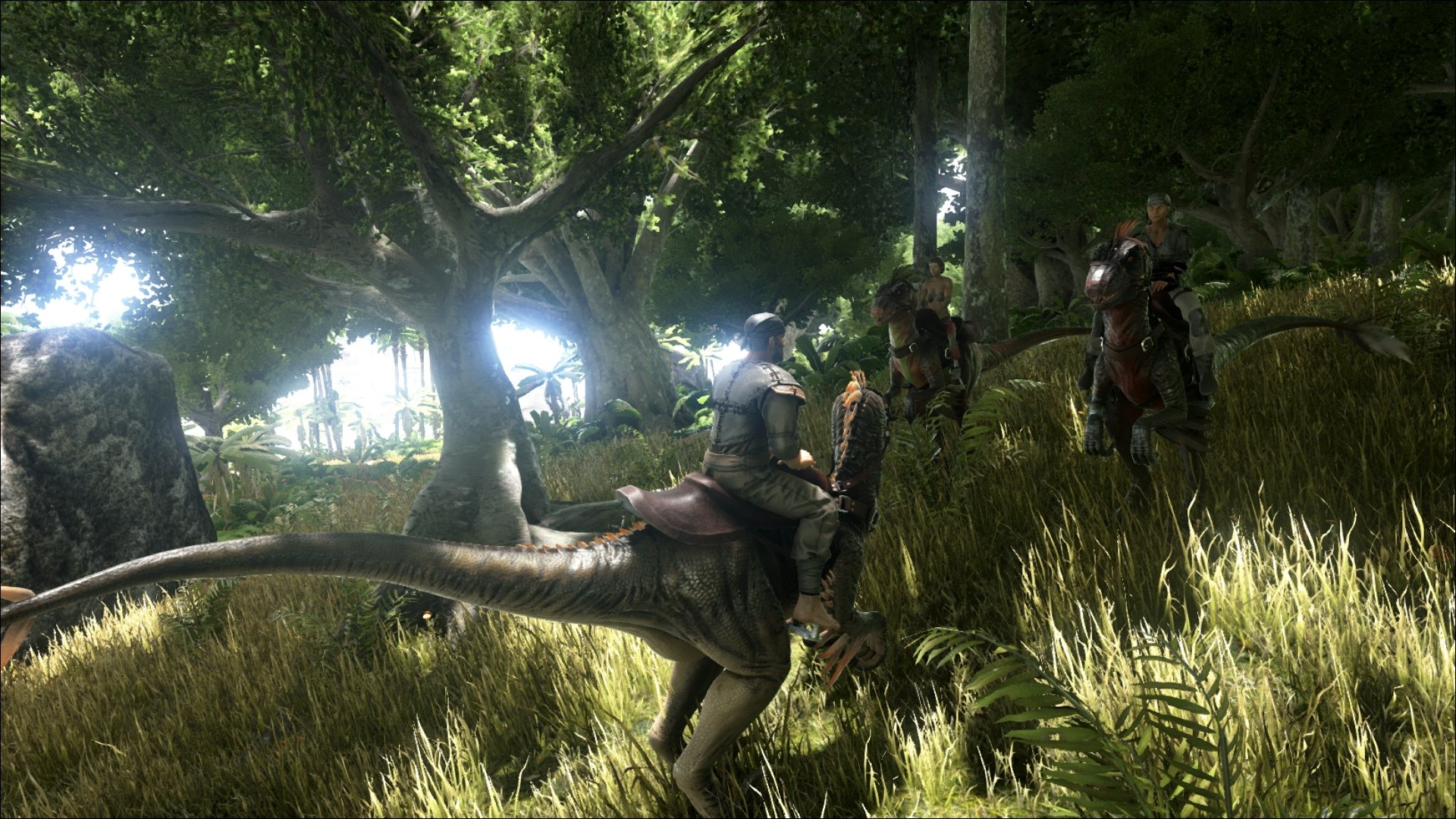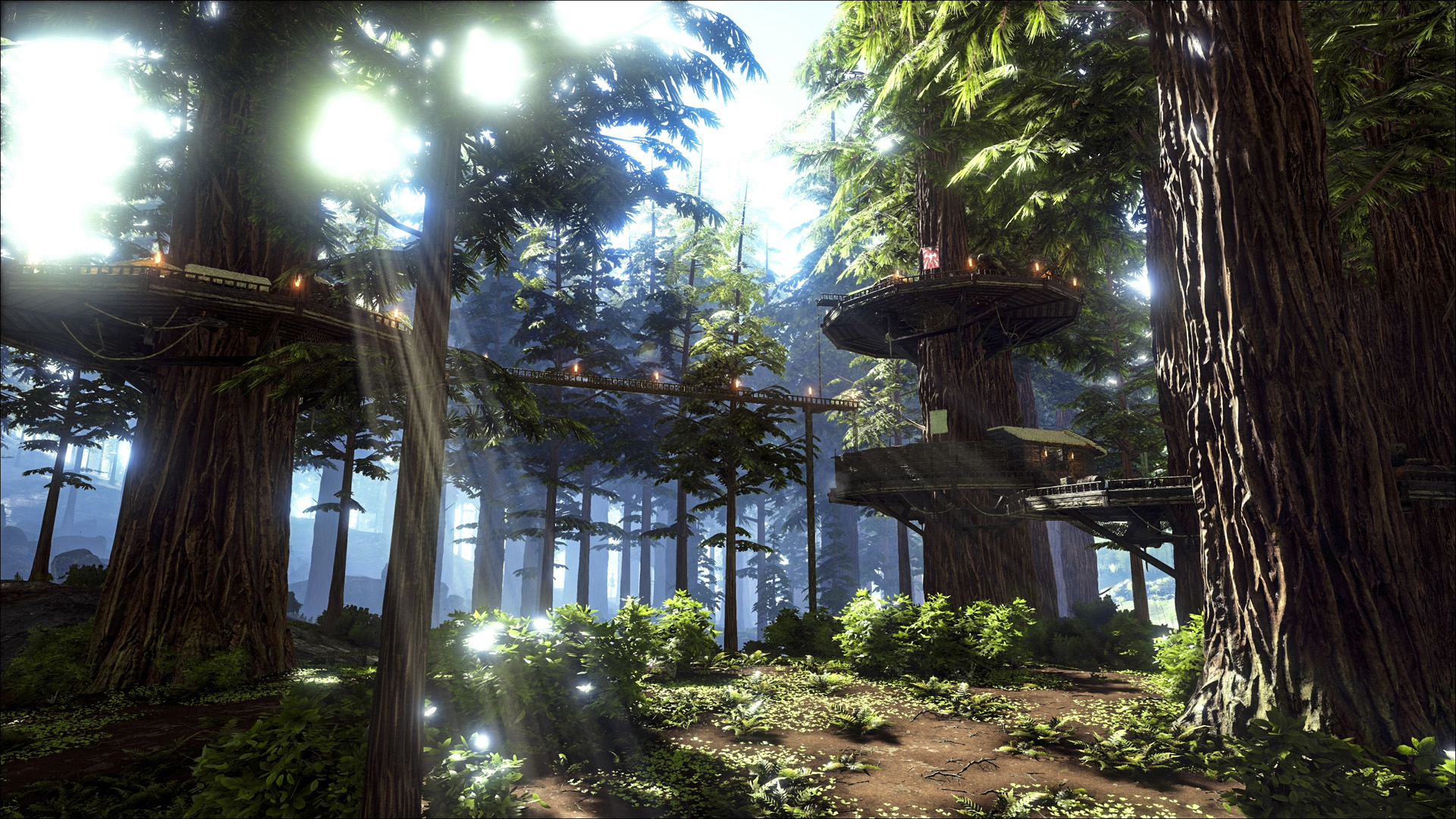I find myself crouching behind a bush in a lush, tropical forest right off the coast of a beautiful beach. To my left the water is reflecting the sky with wonderful ripples and I can see the leaves of trees dancing in the wind. In my right hand I’m grasping a stone-tipped spear and I’m spying on a small raptor dinosaur. Using my head I physically turn to my left and right, checking my surroundings while wearing an Oculus Rift headset, and begin my attack.
After a minute or two of valiantly fighting, the raptor murders me and devours my corpse, forcing me to start over without any of the items I’d built up over the last few hours of playing. Pools of my blood mingle with the sparkling water. That’s the life of a survival sim gamer.
Ark: Survival Evolved by Studio Wildcard shares a lot in common with other popular games in the same genre, such as H1Z1, DayZ, Rust, Conan Exiles, and others. It’s a genre that fits VR extremely well, but it also has very little representation thus far, other than the recently launched The Solus Project.
Survival games are always incredibly immersive experiences but once you strap on a VR headset it feels even more visceral and intense. In the case of Ark, things start out very bleakly on the washed up shores of an abandoned beach without any weapons or supplies.
Before long you’ll be punching trees to get wood, picking up rocks, making hatchets, and then hitting trees with that hatchet. If you’re lucky you might be able to make a bow and some arrows in the first hour or two to take down some dinosaurs from a distance. This is the core gameplay loop of Ark and other survival games like it: you start with nothing and slowly work your way up, grinding for increased power, uncovering new crafting recipes, and gradually building up your resources. It’s a satisfying grind when things work out in your favor, but it’s still a grind nevertheless.
And that grind does have a habit of being a horrible chore at times. There’s nothing worse than getting eaten alive by a triceratops when you’re on your way back to base to drop off supplies and you end up losing hours of work in the process. Getting past that fist curve of finding/making gear, making a base, and reaching the point of being able to recover quickly from death is grueling, but satisfying. Whether playing PvE or PvP the importance of teamwork online cannot be over-stressed.
One of the biggest draws of Ark is the seeming focus on prehistoric tendencies. Whereas Rust focuses mostly on building and fighting other players and both H1Z1 and DayZ inject zombies into the experience, Ark is a bit unique. I can honestly say I’ve never played another game that let me ride a T-Rex into battle and tame a small army’s worth of raptors. Yes, that’s right: you can tame dinosaurs and take them as pets. But that focus on the Jurassic-era gets lost in the weeds of feature-creep eventually.
It’s a fate that befalls Early Access-first and Kickstarter-funded games all too often. The developers set out with a specific idea at hand, such as making a survival game, but with dinosaurs. Eventually they add on more features that make sense like base building and lots of crafting. Soon though the feature creep sets in as more and more things are added to the game that serve little to no function with regard to the game’s core premise. And that’s how you get a game that lets you add lasers to the heads of dinosaurs but doesn’t let you move furniture in your house without destroying it first to rebuild it.
The point here is that adding more things to a game (like being able to eventually craft rocket launchers and laser rifles) isn’t necessarily a bad thing, but it feels incompatible with the original vision of the project. This is amplified by the very nature of survival games that allow player-versus-player (PvP) combat because new players with nothing but a loin cloth and rock will inevitably find themselves at the wrong end of bullets and laser beams more often than not.
Ark feels like a game that’s a bit of a cross-roads trying to be too many things to too many types of people. Due to the prevalence of custom serves and player mods there are still ways to bypass all of the extraneous features weighing the game down and level things out in a way that makes sense, but the community had to take that mission into their own hands with mods like Primitive Plus.
With games like Ark (and even PlayerUnknown’s Battlegrounds, a battle royale-style survival affair) it’s sometimes difficult to identity what denotes good game design and fortunate multiplayer happenstance. Am I having fun because the developers crafted a legitimately good, well-made, and balanced game that rewards hard work and determination? Or am I having fun because near-death experiences with dinosaurs and my friends never gets old? It’s hard to tell.
The frequent bugs, poor AI, and lack of obvious quality of life features make it feel like the latter, but Ark has plenty of actual good elements as well. Playing a game like this in VR is a freeing experience; one that makes me desperately want to see more PC survival sim games.
Ark: Survival Evolved is a good game that gets bogged down by an over-abundance of ancillary features, frustrating bugs, and a horrendous grind. It can be intimidating for new players and playing with friends online is more important than ever. But if you can get past the rough edges and dig into the prehistoric survival fun that makes Ark so special, there is an entirely unique game here that’s unlike anything else you’ll play.
Ark: Survival Evolved is available now on Steam for $59.99 with official support for the Oculus Rift. You can play seated either with a gamepad or keyboard and mouse, motion controller support like Oculus Touch is not included. Read our Content Review Guidelines for more information on how we arrived at this score.

